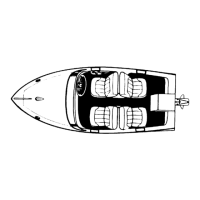CHARGING SYSTEM - 4C-1790-823225--1 1096
POSITIVE (+) RECTIFIER AND DIODES
!
CAUTION
DO NOT use a test instrument with more than a
12 volt source (in the following test), as rectifier
may be damaged.
1. Connect one lead of an ohmmeter (set on R x1
scale) to 1/4 in. stud on positive (+) rectifier heat
sink and the other lead to one of the rectifier ter-
minals. Note the meter reading.
2. Reverse leads and again note reading.
3. Meter should indicate a high or infinite resistance
(no meter movement) when connected one way
and a low reading when connected the other. If
both readings are high or infinite, rectifier is open.
If both readings are low, rectifier is shorted.
4. Repeat Steps 1 through 3 for two other rectifiers
in heat sink.
72834
b
a
c
a - Stud
b - Rectifier Terminal
c - Repeat Test Between These Terminals And Stud
5. Replace assembly if any one of the rectifiers is
shorted or open.
6. Connect one lead of an ohmmeter (set on R x1)
to the common side of the diode and the other
lead to the other side, of one of the three diodes.
72148
a
b
a - Common Side Of Diode Circuit Board
b - Repeat Test For Two Diodes
7. Reverse leads and again note reading.
8. Meter should indicate a high or infinite resistance
(no meter movement) when connected one way
and a low reading when connected the other. If
both readings are high or infinite, diode is open.
If both readings are low, diode is shorted.
9. Repeat Steps 6 through 8 for the other two
diodes.
10. Replace rectifier assembly if any one of the
diodes is shorted or open.
CONDENSER
1. Using magneto analyzer and accompanying in-
structions, perform the following condenser
tests:
a. Condenser Capacity Test (must be .5 mfd).
b. Condenser Short or Leakage Test.
c. Condenser Series Resistance Test.
2. Replace condenser if test results are not within
specifications.

